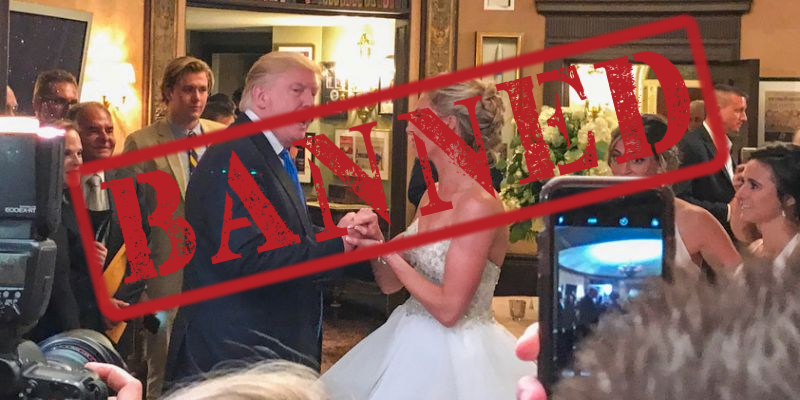
Donald Trump crashes a wedding at his Bedminster Golf Club. Photo modified by the author and used without permission under 17 USC § 107.
In a decision that could have dangerous reverberations for press freedom, a federal district judge ruled last week that Esquire violated a copyright held by a Deutsche Bank vice president when it published his photo of Donald Trump crashing a stranger’s wedding at his New Jersey club.
The photo, snapped on an iPhone and posted to Instagram by another guest, was used to illustrate an article about the president’s unplanned appearances at events at his private venue. Esquire’s parent company Hearst had argued that its inclusion of the photo was a fair use—an argument Judge Gregory Woods rejected in a summary judgment order in Otto v. Hearst last Monday.
That decision could effectively give private individuals—particularly individuals with private access to newsworthy people—inappropriate power to shape or limit the visual coverage of public officials, by allowing them to pick and choose which outlets may run those photos, and under what terms.
Trump’s appearances at his own business locations, from which he and his family still profit, are widely described as evidence of corruption. Images of the president and other public officials at Trump properties have been the basis of dozens of news stories. The photographs themselves are newsworthy and (especially in a time of diminished trust in the media) cannot be substituted by verbal descriptions.
The plaintiff in this case, Jonathan Otto, appears to be willing to license the picture to anybody ready to pay. Indeed, as he texted another wedding guest to whom he had sent the image: “Hey, TMZ & others using my photo above without credit/compensation. You send to anyone? I want my cut.”
But it’s important to note that, if the law deems a license for this sort of photo is necessary, that license would be issued entirely at the discretion of the copyright holder. Otto could offer his photo only to outlets known to provide favorable coverage of the president, say, or charge a rate prohibitive to smaller operations.
It is a bad policy that gives any individual—especially an executive at a bank with extensive financial ties to the president—the power to control whether and how journalists can present newsworthy images to the public.
Instead, judges should interpret the fair use doctrine to give the widest possible berth to journalists. This is consistent with the law. Fair use is determined on a case-by-case basis, but the legal test that judges apply explicitly names “news reporting” as one of the purposes for which it is intended. There are a few technical possibilities for how attorneys and judges can make that argument, but—especially given the potentially ruinous damages associated with copyright violations—the effect must be a firm understanding of broad fair use rights.
Judge Woods nods to such a possibility in a section acknowledging the “fact-driven nature” of fair use analysis, saying:
It is not unreasonable to think that the use could be considered fair in another matter involving a news publisher’s incorporation of a personal photograph. Though the Court did not find fair use in this particular instance, it does not preclude a finding of fair use in in other matters, depending on the balance of the fair use factors. Therefore, the Court emphasizes that a finding of fair use in a matter involving personal photographs used by the media might be readily sustainable on facts other than those presented here.
The circumstances of this photo and its publication, though, precisely fit a fact pattern that needs to be allowed. Some of the facts that Judge Woods ruled weighed against a finding of fair use:
- The article was about the event depicted in the photo, not about the photo itself. But that will nearly always be the case with news reporting.
- Esquire included the entire photograph, instead of cropping or editing it. But presenting the audience with the primary source materials is a valuable and important practice, and shouldn’t be discouraged by the law.
- There is a potential market for such a work because an outlet like TMZ is willing to pay a licensing fee. But the fact that there are willing licensees doesn’t and shouldn’t change the newsworthiness analysis. A single outlet can’t be allowed to render other uses unfair simply by “establishing a market”—especially considering this subject already allegedly worked with a gossip publication to keep other outlets from doing fair reporting.
Fair use is a balancing test, and the ideal of a free press and an informed public outweigh the policy goal of bestowing outsized media influence or a licensing paydays on people who attend weddings at Trump properties.
The situation is especially urgent because of a second New York court ruling issued earlier this year, Goldman v. Breitbart, which cast uncertainty on another time-tested technique for reporting on material sourced from social media sites.
In that case, Judge Katherine Forrest broke with a long-standing rule called the "server test," which says that operators of websites aren’t liable for material that is simply embedded from other sites around the web. In many cases, determining the copyright status of newsworthy images can be prohibitively difficult and time-consuming; the server test simplified that process, giving publishers and journalists an easy rule to follow.
There may be other reasons a publisher wants to serve their own media—to preserve it in case the original is modified or deleted, or to protect the privacy of their readers by limiting third-party assets—but the server test at least sidestepped the copyright considerations. If publishers decide they can no longer rely on the server test, they could be forced to turn more to licensing agreements and fair use.
That case is still proceeding through the court system (delayed in part by the unexpected retirement of Judge Forrest) and both cases are likely wind their ways through eventual appeals. But in the meantime, reporters and publishers are left with fewer safe options for including public and newsworthy images than they had at the beginning of 2018.



